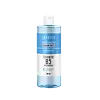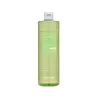What's inside
What's inside
 Key Ingredients
Key Ingredients

 Benefits
Benefits

 Concerns
Concerns

 Ingredients Side-by-side
Ingredients Side-by-side

Water
Skin ConditioningPropylene Glycol
HumectantPEG-6 Caprylic/Capric Glycerides
EmulsifyingPanthenol
Skin ConditioningCeramide NP
Skin ConditioningSodium Hyaluronate
HumectantSaccharide Isomerate
HumectantCollagen
MoisturisingSodium PCA
HumectantNiacinamide
SmoothingGlycine
BufferingButylene Glycol
HumectantDipropylene Glycol
HumectantSerine
MaskingGlutamic Acid
HumectantAspartic Acid
MaskingLeucine
Skin ConditioningAlanine
MaskingLysine
Skin ConditioningArginine
MaskingTyrosine
MaskingPhenylalanine
MaskingProline
Skin ConditioningThreonine
Valine
MaskingIsoleucine
Skin ConditioningHistidine
HumectantSorbitol
HumectantAllantoin
Skin ConditioningHydrogenated Lecithin
EmulsifyingDisodium EDTA
Ethylhexylglycerin
Skin ConditioningSodium Polyacrylate
Absorbent1,2-Hexanediol
Skin ConditioningCetearyl Olivate
Sorbitan Oleate
EmulsifyingCetearyl Alcohol
EmollientCitric Acid
BufferingSodium Citrate
BufferingPropanediol
SolventWater, Propylene Glycol, PEG-6 Caprylic/Capric Glycerides, Panthenol, Ceramide NP, Sodium Hyaluronate, Saccharide Isomerate, Collagen, Sodium PCA, Niacinamide, Glycine, Butylene Glycol, Dipropylene Glycol, Serine, Glutamic Acid, Aspartic Acid, Leucine, Alanine, Lysine, Arginine, Tyrosine, Phenylalanine, Proline, Threonine, Valine, Isoleucine, Histidine, Sorbitol, Allantoin, Hydrogenated Lecithin, Disodium EDTA, Ethylhexylglycerin, Sodium Polyacrylate, 1,2-Hexanediol, Cetearyl Olivate, Sorbitan Oleate, Cetearyl Alcohol, Citric Acid, Sodium Citrate, Propanediol
Water
Skin ConditioningDipropylene Glycol
HumectantPEG-7 Glyceryl Cocoate
EmulsifyingPEG-6 Caprylic/Capric Glycerides
EmulsifyingCentella Asiatica Extract
CleansingVincetoxicum Atratum Extract
Skin ConditioningHamamelis Virginiana Extract
AntiseborrhoeicMelaleuca Alternifolia Leaf Extract
PerfumingMelaleuca Alternifolia Leaf Oil
AntioxidantButylene Glycol
HumectantPEG-40 Hydrogenated Castor Oil
EmulsifyingPEG-60 Hydrogenated Castor Oil
Emulsifying1,2-Hexanediol
Skin ConditioningDisodium EDTA
Sodium Citrate
BufferingEthylhexylglycerin
Skin ConditioningCaprylyl Glycol
EmollientPhenoxyethanol
PreservativeWater, Dipropylene Glycol, PEG-7 Glyceryl Cocoate, PEG-6 Caprylic/Capric Glycerides, Centella Asiatica Extract, Vincetoxicum Atratum Extract, Hamamelis Virginiana Extract, Melaleuca Alternifolia Leaf Extract, Melaleuca Alternifolia Leaf Oil, Butylene Glycol, PEG-40 Hydrogenated Castor Oil, PEG-60 Hydrogenated Castor Oil, 1,2-Hexanediol, Disodium EDTA, Sodium Citrate, Ethylhexylglycerin, Caprylyl Glycol, Phenoxyethanol
Ingredients Explained
These ingredients are found in both products.
Ingredients higher up in an ingredient list are typically present in a larger amount.
1,2-Hexanediol is a synthetic liquid and another multi-functional powerhouse.
It is a:
- Humectant, drawing moisture into the skin
- Emollient, helping to soften skin
- Solvent, dispersing and stabilizing formulas
- Preservative booster, enhancing the antimicrobial activity of other preservatives
Butylene Glycol (or BG) is used within cosmetic products for a few different reasons:
Overall, Butylene Glycol is a safe and well-rounded ingredient that works well with other ingredients.
Though this ingredient works well with most skin types, some people with sensitive skin may experience a reaction such as allergic rashes, closed comedones, or itchiness.
Learn more about Butylene GlycolDipropylene Glycol is a synthetically created humectant, stabilizer, and solvent.
This ingredient helps:
Dipropylene glycol is technically an alcohol, but it belongs to the glycol family (often considered part of the ‘good’ alcohols). This means it is hydrating and gentle on skin unlike drying solvent alcohols like denatured alcohol.
As a masking agent, Dipropylene Glycol can be used to cover the smell of other ingredients. However, it does not have a scent.
Studies show Dipropylene Glycol is considered safe to use in skincare.
Learn more about Dipropylene GlycolDisodium EDTA plays a role in making products more stable by aiding other preservatives.
It is a chelating agent, meaning it neutralizes metal ions that may be found in a product.
Disodium EDTA is a salt of edetic acid and is found to be safe in cosmetic ingredients.
Learn more about Disodium EDTAEthylhexylglycerin (we can't pronounce this either) is commonly used as a preservative and skin softener. It is derived from glyceryl.
You might see Ethylhexylglycerin often paired with other preservatives such as phenoxyethanol. Ethylhexylglycerin has been found to increase the effectiveness of these other preservatives.
This ingredient is derived from caprylic and capric acids. It is an emulsifier with emollient properties.
According to the manufacturer, it is hydrophilic and soluble in aqueous solutions (water). They also state this ingredient is stable in a medium pH range (~5 - 8).
As an emulsifier, it helps make oils and oil-soluble ingredients more soluble in water.
Learn more about PEG-6 Caprylic/Capric GlyceridesSodium Citrate is the sodium salts of citric acid. In skincare, it is used to alter pH levels and acts as a preservative.
Its main functions are to maintain the pH of a product and neutralize metal ions.
The acidity of our skin is maintained by our glands and skin biome; normal pH level of skin is slightly acidic (~4.75-5.5).
Being slightly acidic allows our skin to create an "acid mantle". This acid mantle is a thin barrier that protects our skin from bacteria and contaminants.
Learn more about Sodium CitrateWater. It's the most common cosmetic ingredient of all. You'll usually see it at the top of ingredient lists, meaning that it makes up the largest part of the product.
So why is it so popular? Water most often acts as a solvent - this means that it helps dissolve other ingredients into the formulation.
You'll also recognize water as that liquid we all need to stay alive. If you see this, drink a glass of water. Stay hydrated!
Learn more about Water